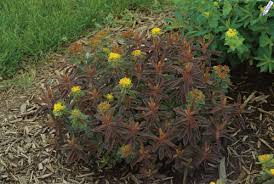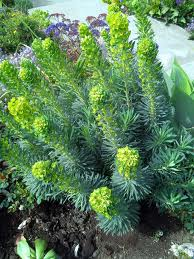By Carolyn Melf, Butte County Master Gardener, March 21, 2014
Looking for a drought tolerant plant? Euphorbias are one of the most dramatic garden plants. The genus is expansive and includes 2000 species of herbaceous perennials, annuals and biennials, as well as evergreen and deciduous shrubs. You might think you are unfamiliar with this plant family, but one tender (and colorful) variety of euphorbia is customarily purchased during the holiday season: the Poinsettia. The Pointsettia's red leaves surround a “flower” called a cyathium, which is really a structure that consists of fused bracts that form a cup around the (actual) tiny flowers.
Euphorbias originated in southwestern Asia, Europe, Australia and the Mediterranean. They are un-thirsty plants which prefer well-drained soil, and can be grown in either full sun or partial shade. Euphorbias are not fussy about soil type either; they are tolerant of normal, clay, neutral or acidic soil. And they are easy to maintain: give them a little water to get it established, but thereafter allow the soil to dry out between thorough waterings.
Classified as an Evergreen Spurge, “Tasmanian Tiger” grows 3 feet wide and high with bow-tie like flower bracts edged in white. The conical flower heads appear in spring. Prune spent flower heads and stems down to the base of the plant—new ones will form during the summer. This euphorbia provides interest all four seasons in our mild climate.
Euphorbia “Polychroma” is another showy variety that looks especially lovely alongside spring-blooming tulips and other bulbs. It is also known as cushion spurge. Its bright golden flowers sit atop cushion-shaped light green leaves. This versatile plant is useful in edgings, rock gardens and containers. And autumn brings an extra treat: red foliage color. Trim this plant back hard to 4 inches in early summer to maintain a bushy, compact size. 
Euphorbia “Ascot Rainbow” matures at 20 inches wide by 20 inches high. The edges of its narrow, gray-green leaves are edged in yellow, and it has variegated cream, lime and green flower bracts. In cooler months, the foliage at the ends of stems can take on a rosy hue. This more compact plant is attractive in groupings.
If your garden is plagued by deer and rabbits, they will avoid euphorbias because the stems of these plants contain milky white sap that can be an irritant to the skin or toxic if ingested. It is a good idea to handle euphorbias with gloves to avoid getting the sap on your skin or in your eyes. The sap has a latex base, so it is also good practice to clean your pruners after using them on euphorbias, to help maintain a sharp blade.
Euphorbias make unusually attractive cut flowers that can be incorporated in floral arrangements. To prevent the sap from bleeding, dip the stems in boiling water or seal the stems by holding a flame to them for a few seconds before adding them to an arrangement.
